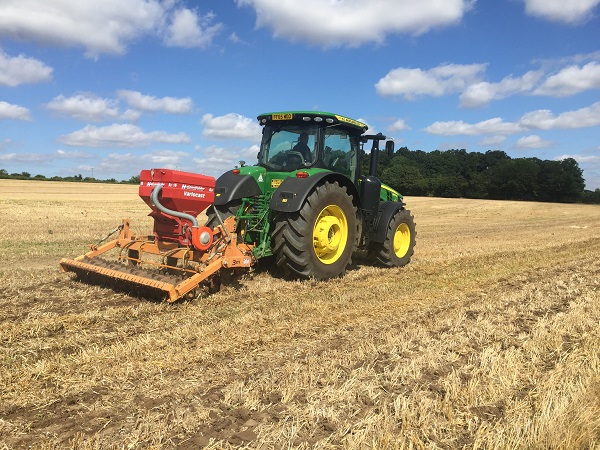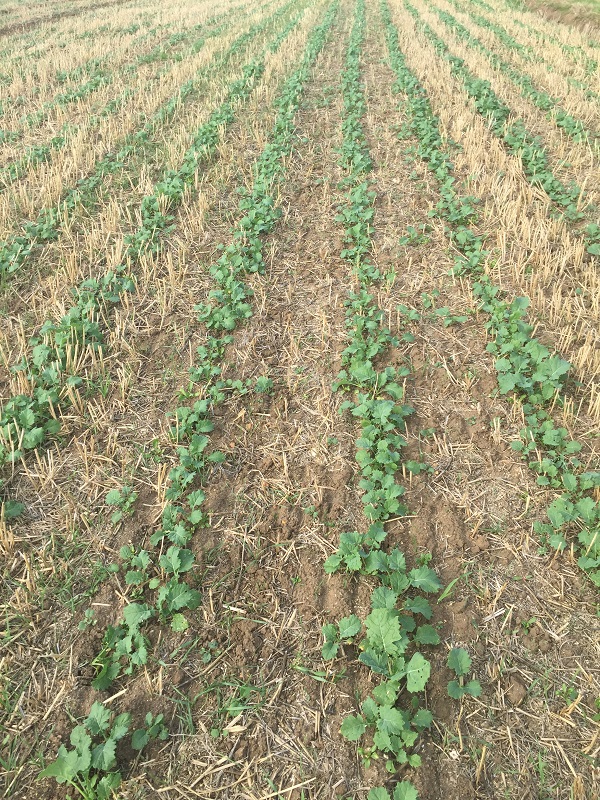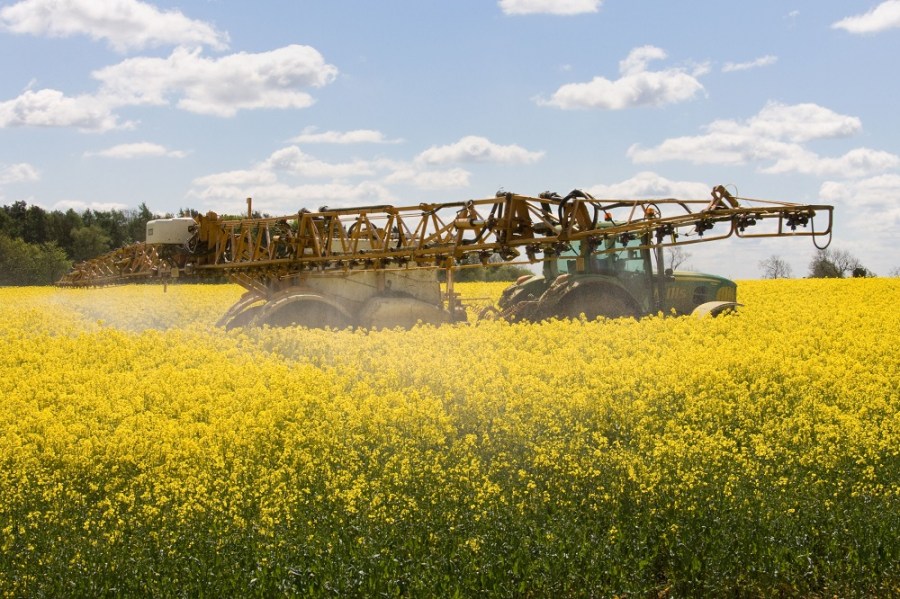A top-performing oilseed rape crop demands close management at key points in the season, but how do you stop it taking over to the detriment of other parts of the business? CPM gleans the experiences of two quite different approaches.
We can’t be dealing with OSRs that need molly-coddling.
By Rob Jones
Just getting jobs done in a busy spring can be a challenge, but oilseed rape is a crop that doesn’t respond well to a slapdash approach.
So on the one hand, there’s the requirement for an approach to growing OSR that allows management ease, and it’s one that a Suffolk farm business favours. On the other, there’s the need to build in flexibility, which is where a heavy-land business in Leics has focused its efforts.

The subsoiler-seeder establishment system moves less soil to retain moisture, restricts seedbed weed germination and saves on labour and tractor hours.
Management ease drives Suffolk recipe
Complicated cropping – involving sugar beet, potatoes and other vegetables as well as winter wheat and barley – and the time and spraying commitments that go along with them make ease and flexibility of management key priorities for the 90-100ha of winter oilseed rape grown each year at Wm Kerr Farms, Easton near Woodbridge in coastal Suffolk.
“As well as having to be easy to manage as part of the demanding cropping mix we have on our mainly heavy clay loam ground, we put the premium on consistency in our OSR,” stresses farm manager, Dan Kiddy who also does all the business’ agronomy.
“I’m happy to say we’ve been able to improve this substantially in recent years. Growing OSR once in every 5-6 years, our five-year average yields are running at 4.5t/ha. And last season our oils were a good 45% and input costs under £140/t.”
Essential to this success have been the most robust hybrid varieties established early in Aug in a low cost but highly effective single-pass regime, managed for the most efficient canopies with only the most essential inputs and harvested with patience and care.
“Characteristics other than yield drive our variety choice,” Dan points out. “We want crops that get out of the blocks rapidly and reliably in the autumn. They must have high levels of phoma and light leaf spot resistance. They need to grow away early in the spring. And they must hold onto their seed until we’re ready to combine them.
“Equally importantly, we don’t want to have to go to town on inputs or get every element of timing spot on. With all our other crop priorities we can’t be dealing with OSRs that need molly-coddling.”
For the past three seasons, Wm Kerr Farms have only been growing hybrids. Not because they’re hybrids, Dan hastens to add. But simply because the particular hybrids they’re growing meet their criteria better than other varieties.

Double rolling ensures good seed-to-soil contact and a clod-free seedbed.
Like last year, the current crop is all DK Exalte. As well as its particular speed of autumn and spring growth and disease resistance, their preference for the variety goes back to 2016 when it remained virtually untouched by one of the worst hail storms in recent memory 10 days ahead of harvest – a storm which bleached white the entire area of another leading hybrid growing alongside it in the same field.
“The precise dividing line of damage across the field left me baffled at first,” admits Dan. “Until I checked the drilling notes and found it exactly marked the boundary between the two varieties. This and a yield difference of almost 2t/ha convinced me that pod shatter resistance was an essential for us, not just a nice-to-have.”
A 10-year old 3m Simba Flatliner with low disturbance legs, fitted with a Hatzenbichler seeder, establishes the crop. This moves far less soil to retain moisture, restricts seedbed weed germination and saves on labour and tractor hours at a hugely busy time, reckons Dan. Sown in 60 cm bands, this gives the freely-branching crop the space it needs to develop a good broad canopy.
Sowing depth control isn’t as good as it might be, so seed rates are kept relatively high at 40-45 seeds/m². “We’re getting nice even crops that come up rapidly to cope very well with slug and flea beetle attack.
“We’re also taking advantage of the establishment vigour we have in our chosen varieties and sowing from the second week in Aug to make the very most of the autumn growing window.” Double rolling – along the drilling lines then at 45° – and a strict 6km/h speed limit ensure good seed-to-soil contact and a clod-free seedbed.
“This regime allows our OSR to grow away from slugs and flea beetle without too much agrochemical support. This season we needed a single main slug pelleting in most cases. And we only had to use one flea beetle spray.”
A single autumn fungicide, mainly targeted at early LLS protection, is all that’s needed with the strong varietal phoma resistance Dan insists upon. Although sowing a fast-developing variety early means big crops at this stage, he avoids any autumn plant growth regulation, and he reckons the tactic paid dividends this year. “The prolonged winter and intense late pigeon pressures meant the last thing our OSR would have needed was an enforced pre-Christmas growth check.”
Thick-stemmed crops supported by good amounts of nitrogen for pod-fill and stay-green chemistry present an obvious challenge for harvesting. Even so, the insurance of pod shatter resistance allows the Abbey Farm team to hold off on desiccation for as long as possible to maximise both yield and oil content while minimising red seed.
“Knowing we’ll only lose a few seeds from the more mature pods even if the weather turns against us gives us the confidence not to go in with the glyphosate until the lower pods are good and ready,” points out Dan. “It also means we no longer bother with a pod sticker so we don’t have any of the stickiness and elevated moisture contents at combining we used to have.”
While Dan reckons they’ve got most things about right in their OSR management, with the combine yield meter routinely showing 8t/ha in patches, he knows they’ve plenty of room for further improvement. However, he’s only keen to secure this if it doesn’t involve any unnecessary equipment investment, extra inputs or loss of critical management ease and flexibility.
“OSR has to perform for us,” he concludes. “But it also has to fit in with our whole farming operation; which means not using up precious time and sprayer capacity, in particular. Otherwise, it simply wouldn’t be worth us continuing to grow the crop.”
Flexibility the watchword in Leics
The greatest possible day-to-day flexibility in every aspect of OSR growing is the focus for manager, Frazer Jolly and Farmacy agronomist, Sally Morris at Saltby Farms on the north eastern edge of Leics between Melton Mowbray and Grantham; a flexibility that means one 40ha field was sown partly from a Sumo Trio and partly with a Väderstad Rapid drill last autumn to deal with see-sawing weather conditions.
“Between us, Gary Wallace and I do all the fieldwork for our 800ha of cropping,” says Frazer who took up the management reins two years ago. “The one thing Gary’s sick of hearing me say over the phone when he’s sowing our 250-plus ha of OSR is ‘if it’s not right, stop’.
“In my experience, carrying on regardless is the road to disaster. Instead, we need to make the call on the day. The crop is an important part of our business, so we can’t afford to get it wrong by being insufficiently flexible in managing it; especially if we’re to push performance to the consistent 4.5t/ha average we want.”
Growing OSR every other year as the business has been doing for a while, like many in the crop’s East Mids heartland, means yields remain stubbornly below the 4t/ha mark. Even so, at 46% oil last season on a premium LEAF contract and with tight cost control, it continues to generate perfectly acceptable margins alongside top quality milling wheat on the farm’s heavy clay to limestone brash ground.
“Actually, we’re amazed the OSR has been delivering anywhere near 4t/ha with the rotation as close as it is – and, so far, without any clubroot problems,” observes Frazer.
While there are opportunities to extend the rotation, Frazer and Sally are looking to improve a number of areas of OSR management at Saltby Farms – from variety choice and establishment through nutrition and disease control to harvest management. In all these respects, flexibility is their key imperative.
Keeping their eggs in more than one basket is important as far as OSR genetics is concerned. They currently have four different varieties in the ground– two hybrids and two conventional varieties – aiming to match them to the particular needs of their land increasingly closely.
“We need varieties that are consistently good year after year, not just one-year wonders,” stresses Sally. “So the sort of disease resistance, fast autumn development and shatter resistance carried by varieties like DK Extrovert are as important in our choice as gross output ratings. These strengths allow us to get a decent crop even when the weather gets in the way of our best-laid plans.
“Alongside earlier sowing wherever possible, the main thing we’re working hard on is the consistency with which we’re able to sow our seed just below the surface into moisture with the best seed-to-soil contact regardless of the conditions.”
At the moment, the team is maintaining its flexibility with parallel establishment systems that can be switched at a moment’s notice. Given the area of OSR to be drilled and the shortage of time after wheat harvesting, a single Sumo Trio pass with the discs just tickling the surface, sowing slightly to one side of the legs to prevent too much seed going in too deep, is the preferred approach.
Run right behind the combine, this is a very rapid and economic regime and highly effective when conditions are right. When the weather turns as wet then hot as it did last autumn, though, the system’s lack of sowing depth consistency becomes all too apparent in large amounts of seed being held up in the straw mulch, germinating within it and failing to establish.
Under these circumstances, Frazer has found the farm’s main Väderstad Rapid drill – with every other coulter blocked-off to give similar 50 cm sowing bands – gives much better seed placement, drilling into previously Trio’d ground.
“An extra pass isn’t ideal given our time constraints, but it’s worth it to get the even establishment we need,” he says.
“With rolling every bit as crucial – not least in minimising slug and flea beetle problems – we stop drilling too whenever conditions mean we can’t roll immediately afterwards and only start again when we know we’ll be able to roll.”
All the Saltby Farms OSR goes in at between 50-60 seeds/m², with the seed rate varied manually to conditions in each part of the field. The same manually varied approach goes for slug pelleting, which ensures they only use the inputs they need where and when they need them.
“Strong disease resistance in our varieties means our single autumn fungicide spray – in early-mid Nov, depending on conditions – tends to be tebuconazole, with a bit of prothioconazole included for varieties with lower LLS resistance than we’d like,” says Sally.
“We’re equally flexible in the timing of our stem extension spraying, incubating leaves regularly to make sure we can keep ahead of any LLS development.”
Leaf tissue testing in both the autumn and spring ensures any nutrients the crops are short of – mainly boron and molybdenum – are included with the sprays whenever they’re needed.
Looking to push the crop a little harder, Frazer and Sally are putting a greater management focus on the period from flowering to harvest as they see that as a key area for improvement alongside establishment. In particular, they’re intent on keeping the canopy as green and efficient for as long as possible through more even flowering, stay-green chemistry and better all-round nutrition.
They see leaving their OSR as long as possible before going in with the glyphosate as another good opportunity to gain both yield and oil content.
“As well as flexibility we’re pretty good at patience here,” concludes Frazer. “With so much of the yield coming from the lower pods these days we’re never in any hurry to desiccate. And last year we didn’t need to spray one block at all. So this is another area in which we’re keeping up the closest monitoring so we can make the call on the day.”
Sustainable OSR
Knowing that success with oilseed rape is as much about what you do as how you do it, Dekalb is working with CPM to share the experience of successful growers with a broad range of different establishment and management approaches.
This sponsored series is all part of our role in providing trusted support and partnership to OSR growers that goes well beyond the most robust and dependable varieties.
We hope you find this series of value in helping you fine-tune your own production for the most sustainable success.




